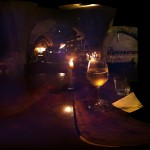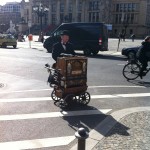It’s time to break this dry spell on the blog. Let’s begin with some notes I jotted down on the plane back from a trip to Tel Aviv and Berlin a couple of weeks ago.
For me, the antisymmetrical ideas of living in Germany or of living in Israel are equally troubling. In Israel, something twists within when I see those fit high-school-looking girls, noses speckled with freckles, wellturned limbs hidden by baggy military fatigues, loaded machine guns slung across their straight backs. It’s sexy, and it’s horrifying. And to a native, of course, it’s matter-of-fact, and it’s irritating, a cliché, when foreigners comment on it.




Then in Germany. The Neues Museum, last of the Museumsinsel structures to be rebuilt, an impressive architectural project by David Chipperfield. His mandate was to reuse as much of the original masonry as possible. So the facades are pocked everywhere with bullet holes, ranging from the grape-sized gouges of small arms to the melon-sized craters of artillery shells. This was the entire city in 1945.
When was such latent violence palpable in American cities? In 1920s Chicago, I’m sure. Perhaps it felt this way in Austin, Texas in the late 19th century too, when the wide boulevards that now convey SxSW hipsters from one bar to the next were paved with nothing but brown dirt, and the citizens wore holstered revolvers on their belts, and the odd native American was eyed with the suspicion now afforded Arab workers. The US, though young by Old World standards, is far removed from the violence of its formative period in a way that Germany and Israel aren’t.
OK, but I think I could live in Israel, if— and only if— I were in Tel Aviv. And Germany could conceivably work for me— but only in Berlin. I really like both of these cities. They’re full of life, full of great design, full of a kind of hipness that frankly makes San Francisco— let alone Seattle— feel like the burbs.
Notwithstanding the above, some unflattering notes on the Hebrew language–
At its core Hebrew sounds prokaryotic. A reanimated Biblical relic, the Jurassic Park of languages. A blunt lettering with no lowercase and nothing much in the way of vowels, suitable for a scroll or a crudely incised boulder. Cue flocks of sheep, scabby nomadic shepherds with knobby knees and bony shanks.
Cursive Hebrew does show promise, and one sees it sometimes on the blackboards of Tel Aviv’s fish restaurants and coffeeshops. Like the uncial scripts that eventually led to the modern mixed-case Roman letterforms, it simplifies, humanizes, and adds nuance to the characters. It would be nice to see more of this.
But by and large, I find the typography horrific, perhaps second only to the brutally geometric Korean Hangul in ugliness. Bad typography is one of the things that, in my view, lends a shabby air to many urban scenes in Israel. Whatever brutal God-of-Abraham, God-of-Isaac aesthetic these block letters do have is corrupted by the unharmonized introduction of left-to-right English words and Arabic numerals, and the haphazard borrowing of the questionmark, quote and comma. These symbols work with Roman letters, and scan visually left-to-right, cupping the preceding sentence or phrase. Stuck on the end (beginning?) of a Hebrew sentence, or leaning out from the end of a word, they look like ass.
 It’s a mystery to me why they didn’t at least mirror these symbols across the y axis. But borrowing is the name of the game in the Israeli language. Although I speak no Hebrew at all, nor any language near it on the linguistic tree, I found myself almost able to follow some businessmen at the next table in a café, because they made such promiscuous use of loanwords and onomatopoeia (not to mention suggestive hand gestures). With their “partee” and their “sho biznes” and their “geemeek” and their “non eevent”, they’re like the anti-French.
It’s a mystery to me why they didn’t at least mirror these symbols across the y axis. But borrowing is the name of the game in the Israeli language. Although I speak no Hebrew at all, nor any language near it on the linguistic tree, I found myself almost able to follow some businessmen at the next table in a café, because they made such promiscuous use of loanwords and onomatopoeia (not to mention suggestive hand gestures). With their “partee” and their “sho biznes” and their “geemeek” and their “non eevent”, they’re like the anti-French.
Based on these observations, I have an alternative theory of kaffei hafukh, which translates to “upside-down coffee” and is the term used for cappuccino in Israel. I think the hafukh is onomatopoeia for the sound of milk frothing. Even if there’s a more structural meaning, the Israelis are suckers for sound. You can just tell when you listen to them in conversation (something they never do with each other). blablaBLA, blablaBLA, harmonizing with one another always in triple meter, anapest that’s called, fittingly enough.





6 Responses to tel aviv / berlin